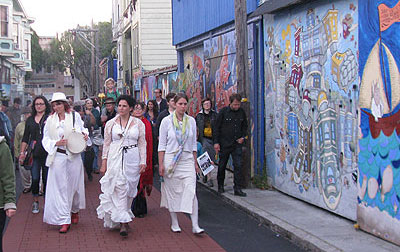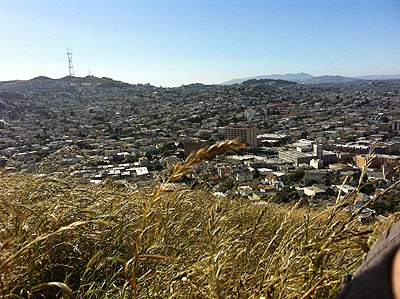Excavating the City’s lost history
Excavating the City’s lost history
In Home and Eviction, Camarena continues to collect current oral histories from migrant workers and multi-generational residents of the Mission about distance, belonging, and displacement. We are in a historic third wave tech boom epidemic of eviction in the City that is definitively changing the character of this once-upon-a-time cohesive migrant working class neighborhood. This section reflects on the intangible cultural loss for the City, as migrants and low income populations are pushed out.
Once upon a time, long before the Mission was El Barrio and a hipster incubator, it was simply a watershed. The Ohlone placed shellmounds near major waterways and bay estuaries. There would have been shellmounds, here, near the creeks and seasonal lagoon of the Mission, but these were disturbed a long time ago.
We know from other shellmounds that they are composed of refuse: mussels, clams, cockleshells, and oyster shells, interspersed with: ash from cooking; mammal bones of rodents, rabbits, deer, elk, bear, and sea and river otters; fish bones; bird bones, mostly of duck and geese but also egrets and herons. These bones alone reward us with a memory of a world in which non-human species dominated this place.

Over the last three decades, several waves of tech booms and housing bubbles have eroded the character of this multi-racial, predominantly Latino, working class neighborhood. As lower income workers are pushed out of their homes by the shenanigans of private property markets catering to high earning professionals, the cultural diversity of the Mission is supplanted by the drab sameness of mainstream monoculture. We are at a loss.
On June 1st as part of the MAPP events, Adriana Camarena in collaboration with Mission poets, artists, and residents walked the night regretfully asking: "Where are my Mission children?/ ¿Dónde están mis hijos de la Misión?" The poetic action was made in the likeness of the legendary *La Llorona* (The Weeping Woman). The procession meandered through Harrison Street, Treat Ave, Balmy Alley, Treat Street, Lucky Street, Treat Street, Folsom Street, and 24th Street ending at the new location of Adobe Bookstore (after being evicted from 16th Street) for a viewing of maps and art referencing gentrification and eviction in the Mission. The exhibit “Layers of History: Mapping 40 Years of Resistance” was curated by Chris Carlsson and Paz de la Calzada.
La Llorona 8.3.13 from David Martinez on Vimeo.
It is 7 a.m. in The Mission. Dogged Latino migrants carve the pavement to the bus stops. Obdurate homeless undock their shopping carts and billow away with garbage bag sails. Mulish children are towed to school by unyielding parents late for work. Caffeine-addicted professionals shudder into the cafés. Little old Catholic ladies resolutely bend their heads towards Saint Peter’s. The Mission is stubborn, bullheaded, and the 14 Muni bus brakes with an exaggerated exhale to reluctantly gather the service workers and the insane for the herky-jerky journey down Miracle Mile. Strung-out addicts dot the sidewalks: fragile, starving, raving birds out for their morning worm.

The camotero used to come out at night to sell roasted sweet potatoes (camotes). He kept them warm in a metal stovepipe on wheels that released a whistle to announce his presence on a street. In the summer, the sound carried throughout the La Condesa neighborhood of Mexico City. Lupe, nanny to my mother and her eight siblings, would put my five sisters and me to bed on our summer visits to our grand- parents’ place. She drew the blinds closed to block out the twilight and told the story of the time the family dog Penchi escaped, then returned mangy and world-weary to the house. She groomed him and made him well. She would repeat this story until the sound of the camotero sig- naled that the veil of dreams was thin enough to cross.
La Condesa is now often called La Fondesa, a reference to the fondas, or bistros, that have blanketed the middle-class art deco neighbor- hood by ignoring residential zoning laws and filling every street corner with valet parking to accommodate the transient diner and drinker. The camotero still makes his rounds in the evening, but his whistle is less distinct amid the pounding bass of the neon-lighted bars.
I now live 2,000 miles north, in the Mission District of San Francisco, a Latino barrio that is changing in much the same way that La Condesa has changed. For decades the Mission’s apartments were owned by working-class Poles, Russians, Germans, Irish, and Italians. My landlady Frances inherited her building from her Italian-American father, an ironworker at the docks; she was still a teenager when she helped him pick it out. Lucca’s Deli on 22nd and Valencia and Dianda’s Italian-American bakery on Mission and 24th are lingering mementos of an Italian past. Over by Shotwell and 22nd is the old Polish Club, or Dom Polski, among other remnants of a European Mission.
Shaping San Francisco is fiscally sponsored by Independent Arts & Media, a California non-profit corporation.